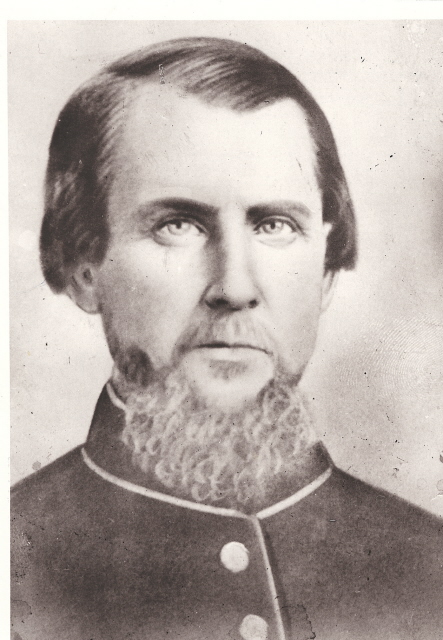|
OLD SORREL—A condensation of a
monograph by his great grandson, Rev. Robert E. Walker.
By Orrin Manifold
Source: NMHS Newsletter, Nov 1986
Old Sorrel is the 1985 account of
Gilbert Moore, a Chester Township farmer and American
Civil War soldier. At the age of 43, father of eleven
children, he enlisted in the Union Army, fought in
Tennessee, was captured, and died in Andersonville
Prison. The account was researched and written by his
great grandson, Rev. Robert E. Walker. Moore was known
as “Old Sorrel” because of his red hair.
Born in Rush County and married
there in 1842, he and his wife, Delilah, and several
other families moved the next year to Wabash County near
Treaty, and then in 1856 he purchased an 80 acre farm in
Chester Township.
After the Civil War broke out the
Moores’ oldest son, John, enrolled in Company D, 47th
Indiana Volunteers of Infantry. Two of his brothers
would also serve in Company D. In August, 1862, Gilbert
Moore enrolled in Company F, 101st Regiment
of Infantry Indiana Volunteers. He was probably
recruited by Captain Benjamin Williams of Wabash. In
those days a well known man could enlist men and be
elected by them as an officer. The regiment met August
16 in Wabash for organization, speech making, and flag
waving. Joseph, age 18, and Jacob, 16, were old enough
to carry on the farm work.
On September 2 the regiment boarded
the train in Wabash in high spirits. At Noblesville late
in the evening local people fed them chickens and
turkeys, cakes and pies, melons and good coffee. They
were officially mustered into the army September 5 at
Camp Morton in Indianapolis, and each man received a
uniform, a blanket, gun, haversack, and canteen. He had
to furnish his own cup, plate, knife, fork, spoon, and
skillet.
 Two days later they left by train
for Covington, Kentucky, to protect Cincinnati, which
was being threatened by Rebel General Kirby Smith. When
he did not come, the regiment boarded a steamer on the
Ohio River and sailed to Louisville, Kentucky. While in
Kentucky for the next several weeks, they found an
occasion to visit Mammoth Cave. They engaged in action
against “Morgan the Raider,” discouraging him from a
Christmas raid into southern Indiana and Ohio. Two days later they left by train
for Covington, Kentucky, to protect Cincinnati, which
was being threatened by Rebel General Kirby Smith. When
he did not come, the regiment boarded a steamer on the
Ohio River and sailed to Louisville, Kentucky. While in
Kentucky for the next several weeks, they found an
occasion to visit Mammoth Cave. They engaged in action
against “Morgan the Raider,” discouraging him from a
Christmas raid into southern Indiana and Ohio.
In the next months there was brisk
action in central Tennessee against General Morgan and a
concerted campaign in late June to drive the Rebels out
of central Tennessee. The northern troops pushed on
towards Chattanooga, where control of the railroads
there was the key to the whole area. Heavy rains over a
considerable period of time made nasty weather. Often
the men had to wade rivers and creeks that had
overflowed their banks. Several men died in the
hospitals around Murfreesboro.
Confederate General Braxton Bragg,
commander at Chattanooga, decided to make a stand along
Chickamauga Creek, a few miles from Chattanooga. The
battle continued for two days. The night between was
cold, but there could be no fires which would reveal
their locations to the enemy. In the outcome of the two
day battle the northern forces were defeated; but
General Bragg did not follow up on his victory, so the
Union Army claimed Chattanooga and held control of
communications and transportation. This made possible
the capture of Atlanta a year later and Sherman’s March
to the sea.
On the first of the two days the
101st from Indiana plunged into the battle
about noon. About 2:30 p.m. Confederate General
Alexander Stewart made an attack which pushed the Union
army back in this section. Lt. Richard Busick was
wounded and an officer ordered Corporal Gilbert Moore to
stay with him. When the Union Army pulled back, Moore
“refused to leave the lieutenant and was taken prisoner
by the Rebels”—as was also lt. Busick.
From the battlefield he was sent to
a prison in Richmond--probably by way of Atlanta and
Augusta, since the Union forces controlled any direct
route. He arrived there September 29. It is not known in
which of the five prisons he was confined. Most of the
prisons there were brick tobacco warehouses, two or
three stories high. In October General Robert E. Lee
suggested that there were too many prisoners in
Richmond, so six brick or wooden tobacco factories in
Danville, Virginia, were hastily readied to receive
prisoners. Gilbert Moore and William Busick were sent to
one of these Danville prisons December 12, 1863. That
day a smallpox epidemic swept through the city.
At some later time—perhaps in early
march, 1864—Moore and Busick were transferred to the
Andersonville, Georgia, prison. A double stockade of
twenty foot pine longs enclosed 26 ½ acres. Stockade
Creek—about five feet across and a foot deep—was used
for bathing, cooking, drinking, washing clothes, and
flushing out the sinks. As the war continued and the
prison population grew larger, the food deteriorated. In
all, 12,912 men who were imprisoned there died and were
buried in the cemetery. Disease was common—particularly
scurvy, diarrhea, gangrene, and dysentery.
Scurvy makes one’s extremities
swell to twice their size and the patient’s teeth often
become loosed and fall out. It is reported of Gilbert
Moore that “three hours before his death he pulled out
his teeth, then checked into the Prison Hospital where
he died that same day,” probably September 4, 1864, two
days after Atlanta surrendered to General Sherman.
Note: The above photograph
of "Old Sorrel" in Civil War uniform is from the collection of Nancy J. Reed.
Gilbert Moore was Nancy's ggggrandfather.
|